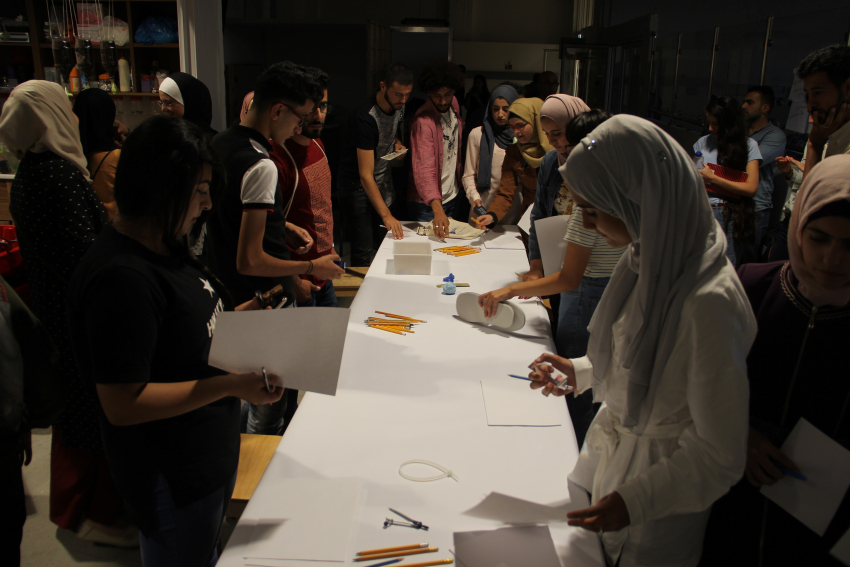
When you put on your coat and get ready to leave your house on a rainy day, you surely won’t think of the importance of the coat buttons, which will protect you from the gusts of cold air. According to Tayma’ Abdul Hadi, a participant in the Design Thinking course, the button is a tool that emerged as a consequence of a series of ideas and experiments. Most often, it has not drawn our attention or engaged our thinking even once.
Tayma’ thinks that she was lucky to have this experience in the Design Thinking course. The Science Studio / Educational Research and Development Programme (ERDP) of the A. M. Qattan Foundation offers this course in collaboration with the Birzeit University. Informed by empathy with the user, Tayma’ has learned how to use resources, no matter how limited they are, to produce the best output.
Towards modelling
The Design Thinking course is at a critical stage. Participants have completed the stage of thinking and understanding, and are about to engage in practical application.
Saja Amro, Science Exhibit Developer at the Science Studio, explains that the paradigmatic shift in the course involves getting done with finding the idea and moving on to create a model for it. This shift helps participants filter the ideas they generate.
This is the last component of the reflection stage and the first element of the modelling stage. Every group of participants has three ideas, which they will work on modelling, ultimately determining which idea they will select and manufacture.
This stage was a culmination of several encounters, which featured a number of stations. Firstly, the meaning of the scientific exhibit was defined and the link between arts, science and technology was determined. Secondly, the meaning of empathy with, and understanding of the needs of, the user was recognised. Students visited a children’s park to project the idea of understanding and empathy on children. Then, students were introduced to the idea of identifying the problem and generating ideas for solution. According to Saja, upcoming encounters will involve the stages of evaluation and manufacturing.
The goal and the beginning
The idea of the Design Thinking course was based on the desire to establish a permanent team of exhibit developers. Worth of note is that the course is not commonly offered by academic institutions. The exhibit developer team usually brings together individuals with different specialisations.
Hiba Burqan, Science Exhibit Developer, states that the course aims at creating a critical community, whose thinking is focused on practical aspects. Hiba says: “We, therefore, decided to approach university students. The course will be offered on campus, so that students can be familiar with the processes the team goes through in the course of developing exhibits – from an idea all the way through to a tangible produce.”
In practice, participants in the course engage in the same processes the developer team use to produce an exhibit, starting with invoking ideas by means of brainstorming, reflection, and modelling.
Hiba indicated that the Science Studio team draws on different persons with a variety of academic backgrounds. These are employed as speakers and facilitators to enrich the course content.
The process is interdisciplinary. Through design thinking, the course has added on the stages of empathy and problem identification to the participants’ background knowledge to ensure empathy with, and meeting needs of, the user.
In this regard, Hiba says: “To achieve this goal, we have engaged participants in a deep theoretical background so that they can realise the meaning, conditions and source of design thinking; i.e. forming a background about the theme at hand.”
In relation to engaging in the modelling process, Hiba explains: “We will initiate the modelling stage. However, we do not expect that participants come up with a fully integrated exhibit. The objective is that they go through the processes so that they can be prepared to embark on a deeper actual experience in the future.”
From her own perspective, Saja drew attention to an important point: “The Studio team has gained new information and experience during the course. They have learned about resources from the students themselves.” Saja added: “I myself have discovered new things in an area I had thought I mastered.”
